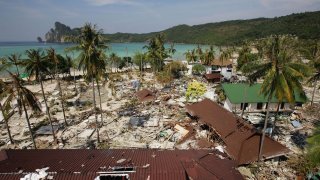
Thousands of people knelt in prayer in Indonesia's Aceh province at ceremonies Thursday marking the 15th anniversary of the Indian Ocean tsunami, one of modern history's worst natural disasters.
The massive Dec. 26, 2004, tsunami was triggered by a magnitude 9.1 earthquake off Sumatra island. The giant wall of water killed about 230,000 people in a dozen countries as far away as East Africa. Indonesia's Aceh province, which was closest to the earthquake, was hit first and hardest.
More than 170,000 people died in Indonesia alone, about three-quarters of the overall death toll.
"No words can describe our feelings when we tearfully saw thousands of corpses lying on this ground 15 years ago," acting Aceh Gov. Nova Iriansyah said at a ceremony in Sigli, a town in Pidie district, “And now, we can see how people in Aceh were able to overcome suffering and rise again, thanks to assistance from all Indonesians and from people all over the world.”
Weeping survivors and others attended religious services and memorial ceremonies. Relatives of the dead and religious and community leaders presented flowers at mass graves of victims in the provincial capital, Banda Aceh.
Shops and offices were closed, boats were not allowed to sail and flags were being flown at half staff throughout Aceh on Thursday and Friday.
Disaster-prone Indonesia, a vast archipelago of more than 17,000 islands that is home to 260 million people, lies along the “Ring of Fire,” an arc of volcanoes and fault lines in the Pacific Basin.
U.S. & World
Thursday's commemoration came four days after the anniversary of last year's Sunda Strait tsunami, which followed the eruption and partial collapse of the Anak Krakatau volcano. That tsunami struck coastal regions of Banten on Indonesia's main island of Java and parts of southern Sumatra island, leaving more than 400 people dead and 14,000 injured.
In Thailand, hundreds of people attended a tsunami memorial ceremony at Ban Nam Khem, a small fishing village that lost about half of its population of 5,000 when the waves rolled in.
More than 8,000 people in Thailand died or went missing in the disaster, and the bodies of almost 400 victims remain unidentified and unclaimed.
Western visitors and local residents attended the service at the Ban Nam Khem Tsunami Memorial Park in Phang Nga province, where they viewed a photo display of victims. A Thai woman handed over an offering of food for Buddhist monks presiding over the proceedings.
The lucrative tourist industry centered around the island of Phuket was devastated by the disaster — as many as half of the victims were foreigners — but quickly bounced back and has grown much bigger.
Many local residents had their houses rebuilt and jobs restored, but still have to cope with the loss of friends and family.
Niwan Chantharawong left a floral offering at a commemorative wall in Ban Nam Khem. She recalled the horror of losing two children in the tragedy.
"I think they didn't die on the day that the tsunami hit. We couldn't find them until the 28th and their bodies hadn't decomposed at all," she told Thai PBS television, with tears welling up. "I often imagine how much they would have thought about me before taking their last breaths. But we could not find them, and we couldn't help them. This has stuck with me. And every time I think about it, it hurts."
Officially, there are between 8,200 and 8,300 dead in Thailand, but about a third of that total are missing, with no confirmation of their fate. An unknown number of bodies were swept out to sea, and the ad hoc evacuation of foreign tourists meant that at least some survivors were never accounted for. Also unclear was what happened to thousands of undocumented workers from Myanmar who did low-wage labor in the area, coming from poor, remote areas with little way to plug into the effort to account for casualties.
According to police Col. Kittipong Thongthip, there are 394 unclaimed bodies at the Bang Maruan tsunami victim cemetery in Phang Nga, where white gravestones are marked with numbers, not names.
Kittipong, who as local police chief oversees the cemetery, said 25 bodies had been confirmed to be migrant workers from Myanmar, but could not be further identified. There are no clues as to the identities of the other 369.
"I don't think we will be able to prove who those bodies are," he said by phone. "It's 15 years now and nobody comes to see their missing loved ones here anymore."



